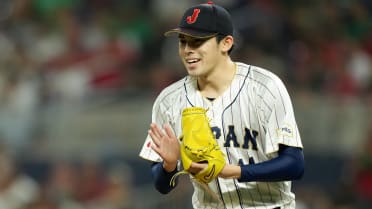Ed Kranepool, longest-tenured Met and 1969 WS champ, dies at 79
Ed Kranepool, the native New Yorker who became an original 1962 Met as a 17-year-old and spent his entire 18-year Major League career with New York, hitting a critical home run in the 1969 World Series for the victorious Miracle Mets, died on Sunday after suffering from cardiac arrest in Boca Raton, Fla. He was 79.
“We are incredibly heartbroken to learn of Ed Kranepool’s passing," said Mets owners Steve and Alex Cohen in a statement. "He was an original Met, who debuted at age 17 in 1962. After starring at James Monroe High School in the Bronx, he would go on to play for his hometown team for the next 18 years, the longest tenured player in franchise history, appearing in 1,853 games with the Mets. Ed hit a home run in Game 3 of the 1969 World Series to help the Miracle Mets capture the title.
"He was inducted into the Mets Hall of Fame in 1990. Ed continued to work tirelessly in the community on behalf of the organization after his playing career ended. We cherished the time we spent with Ed during Old Timers’ Day and in the years since. Hearing Mets stories and history from Ed was an absolute joy. We extend our thoughts and prayers to his family and friends.”
To this day one of the most beloved players in franchise history, a member of the Mets Hall of Fame and still the club’s all-time leader in games played, Kranepool was diagnosed with diabetes shortly after retiring in 1979. He had a left toe amputated in 2017 and underwent a successful kidney transplant in 2019 after a two-year wait – just in time to attend the 50th anniversary of the 1969 World Series championship team that stunned the baseball world with a five-game win over the powerhouse 109-win Baltimore Orioles.
"Sad day for the Mets family and the whole organization after learning of the passing of one of the all-time favorites in Ed Kranepool," manager Carlos Mendoza said on Monday. "[He was] a part of the Mets family, Mets Hall of Famer, fan favorite, part of those big Mets teams. Sad day for all of us."
Kranepool, whose World Series home run keyed the Mets’ Game 3 win, remains in the franchise’s all-time top 10 in many statistical categories. Besides ranking first in games played with 1,853, he is second in plate appearances (5,997); third in hits (1,418), at-bats (5,436) and total bases (2,047); fourth in doubles (225); fifth in RBIs (614); ninth in walks (454); ninth in runs scored (536); and 11th in triples (25). He is 13th in franchise history with 118 home runs and hit .261 for his career.
The 6-foot-3 lefty-swinging first baseman with the decided New York accent was not only the last of the ’62 Mets to play for the franchise, he also was the last of the ’69 Mets to play for the club. The 1969 team led by Tom Seaver, Jerry Koosman, Bud Harrelson and Cleon Jones under the guidance of manager Gil Hodges -- himself an original 1962 Met -- remains one of the most adored teams in New York sports history.
“The best first baseman I ever played with," Koosman said in a statement. "We knew each other so well and I could tell by his eyes if a runner was going or not. He saved me a lot of stolen bases.”
Kranepool was the Mets’ starting first baseman for much of the 1960s, making his lone All-Star team in 1965 (he did not appear in the game). He also played 250 games in the outfield -- mostly left and right but even one in center. That was no small feat for a player of whom Mets manager Casey Stengel said in 1962: “He's only seventeen and he runs like he's 30.”
At the beginning of 1965, Kranepool relinquished his original uniform No. 21 to future Hall of Fame pitcher Warren Spahn, whom the Mets had acquired in a trade. Kranepool wore No. 7 for the rest of his career -- the same as Mickey Mantle of the crosstown Yankees.
The World Series home run was not Kranepool’s only notable postseason moment. In the deciding Game 5 of the 1973 NL Championship Series against the Reds, he delivered a two-run single in the bottom of the first inning, sending the 55,000-plus in Shea Stadium into delirium and kick-starting a 7-2 victory that sent the New Yorkers to the World Series for the second time in five years (Kranepool was pinch-hit for by Willie Mays later in that game). The “Ya Gotta Believe” Mets pushed the defending champion A’s to seven games before falling.
Toward the end of his playing career, Kranepool became one of the game’s preeminent pinch-hitters, batting .396 over a five-year span from 1974 to ’78. In 1974, he set a record for highest batting average as a pinch-hitter in a single season (minimum 30 at-bats), going 17-for-35 -- a surreal .486 clip that still stands to this day. For his career, he had 90 pinch-hits, six of them home runs.
“I was able to motivate myself to pinch-hit and perform,” Kranepool told SABR in a 2008 interview. “I was trying to prove the managers wrong by not playing me, and I wound up very successful.”
Edward Emil Kranepool was born in New York City on Nov. 8, 1944. Just 3 1/2 months earlier, his father, Sgt. Edward Kranepool, had been killed in France during World War II. Raised by his mother, Ethel, with an older sister, Marilyn, Kranepool starred in baseball and basketball at James Monroe High School in the Bronx -- where Baseball Hall of Famer Hank Greenberg had attended years earlier. Kranepool was signed by the Mets right out of high school as an amateur free agent on June 27, 1962, with an $80,000 bonus -- an astounding number in those days. He immediately flew to Los Angeles, where the Mets were playing the Dodgers. Kranepool’s first game in attendance (but not as a player) saw the Mets get no-hit by Sandy Koufax.
After spending a short time at three levels of the Minors, Kranepool made his blue-and-orange debut in September for the expansion ‘62 Mets team that lost a record 120 games. He played in only three games that season with six at-bats and one hit, a double. The following April, he became the youngest Met -- and one of the youngest Major Leaguers ever -- to hit a home run, at 18 years and 162 days old.
“It might not have been to my best advantage to get to the Major Leagues so fast,” Kranepool told SABR in that same 2008 interview. On an expansion team, “you have [more] inexperience than on a better ballclub; a kid of 17 isn’t equipped to handle that pressure. If I was on a good ballclub, the pressure to handle that wouldn’t be so great. With the Mets, we were a bad ballclub. They said, ‘Ed’s going to lead them from a bad ballclub to the pennant.’ One player, even a Hall of Famer, can’t do that.”
Kranepool retired after the 1979 season. He worked in the New York area as a stockbroker, in the credit-card industry and, for a short time years ago, in the restaurant business along with former Mets teammate Ron Swoboda. Kranepool was enshrined in the Mets Hall of Fame in 1990.
He remained a Big Apple celebrity even decades after retirement. He made a cameo on “Saturday Night Live” in 1979, interviewed by “reporter” Bill Murray in a skit centered around the fictitious Mets player Chico Escuela (Garrett Morris).
Kranepool also appeared in a 1999 episode of “Everybody Loves Raymond” -- starring Ray Romano as a New York newspaper sportswriter -- with other ’69 Mets, including Tommie Agee, Jerry Grote, Harrelson, Jones, Tug McGraw, Swoboda and Art Shamsky. Kranepool also had an uncredited role in the 1968 movie “The Odd Couple” starring Jack Lemmon and Walter Matthau, who played another New York newspaper sportswriter, Oscar Madison.
In later years, Kranepool’s medical plight was big news in New York. He was on a much-publicized two-year waiting list for a kidney transplant. When his situation reached a critical stage, a donor was finally found. It was a 56-year-old Long Island woman Deborah Barbieri -- and she happened to be a big Mets fan.
The operation in May 2019 was so successful that Kranepool was able to attend the 50th anniversary of the 1969 Miracle Mets World Series championship just two months later.
Kranepool remained a part of the Mets family, attending Spring Training with the club in 2022.
During the summer of 2022, Kranepool was at Citi Field for the Mets’ first Old Timers' Day in 28 years, where they surprised everyone in attendance by retiring Mays’ No. 24.
Len Hochberg is a homepage editor for MLB.com.




